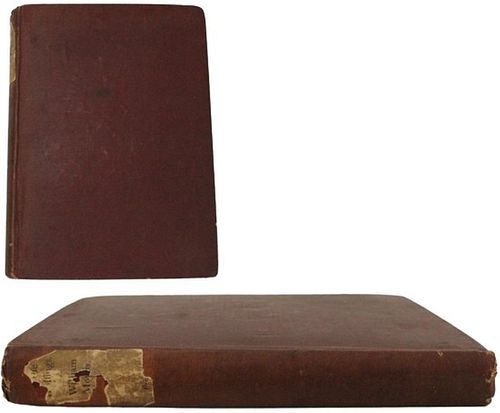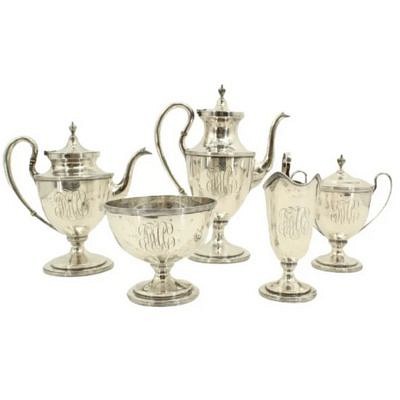William Morris,A Tale Of The House Of The Wolfings
About Seller
522 South Pineapple Avenue
Sarasota, FL 34236
United States
Sarasota Estate Auction specializes in a wide variety of furniture, antiques, fine art, lighting, sculptures, and collectibles. Andrew Ford, owner and operator of the company, has a passion for finding the best pieces of art and antiques and sharing those finds with the Gulf Coast of Florida.
Two ways to bid:
- Leave a max absentee bid and the platform will bid on your behalf up to your maximum bid during the live auction.
- Bid live during the auction and your bids will be submitted real-time to the auctioneer.
Bid Increments
| Price | Bid Increment |
|---|---|
| $0 | $10 |
| $100 | $25 |
| $250 | $50 |
| $1,000 | $100 |
| $2,500 | $250 |
| $7,500 | $500 |
| $20,000 | $1,000 |
| $50,000 | $2,500 |
| $100,000 | $5,000 |
| $250,000 | $10,000 |
About Auction
Jan 20, 2024
Artists to include: Jorge Blanco, Leonardo Nierman, Picasso, LeRoy Neiman, Darrell Crisp, Francois Krige, Mino Delle Site, Peter Max, Edward Povey, Sky Jones, Robert Rauschenberg, and others. There are also 7 Original Charles Schulz Drawings done by Reuben Timmins, Production Cels, over 200 lots of Important Books and Manuscripts, Sterling Silver, a Jane Kostick Geometric Wooden Sculpture, Modern Design and Furniture, Fantastic Estate Jewelry, and so much more! Sarasota Estate Auction sarasotaestateauction@gmail.com
- Lot Description
William Morris, A Tale Of The House Of The Wolfings 1889. This book by William Morris is titled "A Tale Of The House Of The Wolfings And All The Kindreds Of The Mark Written In Prose And In Verse", and it's a first edition presentation copy signed and inscribed "to Ford Madox Brown from William Morris with best wishes Dec. 28th 1888". It was published in London by Reeves And Turner in 1889, with a paper label on the spine, burgundy boards, blank endpapers with the bookplate of Hamilton Easter Field and "first edition with autograph of Morris" in pencil on the front paste-down, Field's name and "London, England, September 1894" inscribed on the front free flyleaf, then the presentation page inscribed by Morris, the half title and title page, the printer's page (Chiswick Press), one page of Contents, and 199 pages of text, with thirty-page ad for a Catalogue of Publications and Remainders by Reeves & Turner's Books dated November 1888 and one leaf titled "Principal Contents" at the rear. The second edition by Reeves was published in 1890 and reprinted in 1896 by Longmans, Green. Longmans then reprinted it five more times, and with Morris' works out of copyright, the book was reprinted by other publishers. William Morris (1834 - 1896) was a famous British designer, poet, artist, novelist, and printer, and a pioneer and one of the founders of the British Arts and Crafts movement; in 1891, he founded his own press, the Kelmscott Press, to publish limited- edition illuminated-style books. This is a fantasy novel by Morris, perhaps the first modern writer to tie together an imaginary world with elements of the supernatural, the precursor to much of modern day fantasy literature, and one of the influences on J. R. R. Tolkien and his popular "The Lord of the Rings". You can see that in the way Morris used Old English-style place-names such as Mirkwood and the Mark, Germanic names such as Thiodolf, and dwarves were called skilled smiths (e.g. "How the Dwarf-wrought Hauberk was Brought away from the Hall of the Daylings"). Ford Madox Brown (1821 - 1893) was a British painter who collaborated on several projects with William Morris and a founding partner of William Morris's design company, Morris, Marshall, Faulkner & Co. Brown painted moral and historical subjects, with a Hogarth style to them. His early works were not successful, but he was greatly admired by the young Dante Gabriel Rossetti, who asked him to become his tutor, and through Rossetti, Brown came into contact with the artists who formed the Pre-Raphaelite Brotherhood; he was never actually a member of the brotherhood, but adopted their bright colors and realistic style. The Tate Gallery also holds an early example of Brown's work, a portrait of his father. From the 1860's, Brown also designed furniture and stained glass. He was a founding partner of William Morris's design company, Morris, Marshall, Faulkner & Co. in 1861, which dissolved in 1874 and Morris continuing on his own. (Morris was a later follower of the principles of the Brotherhood too.) Hamilton Easter Field (1873-1922) was an American artist, art patron, connoisseur, as well as a critic, publisher, and dealer. Highly regarded for his knowledge of Japanese prints and his passion for American folk art, he was also praised for his devotion to contemporary American art and for the support he gave to talented artists. In 1919 he founded The Arts magazine and became its editor, publisher, and main contributor too. The book measures 8 1/4 x 6 1/8 in. wide, with a pretty tight binding, wear on the paper label and the heel and crown of the spine, with offset on the front flyleaf from the bookplate, the front flyleaf is a bit loose at the top part of the gutter, there is light toning near the margins on some pages, a small tear in the top part of the gutter on the last page of the text, wear on one tip, light rubbing on the other tips, the tips are slightly turned in, and the spine has a slight slant to it, and an important work signed by William Morris and given as a presentation copy to Ford Madox Brown, who helped Morris found a design company in the 1860's, and actually a rare copy. The book is a first edition, according to WorldCat, and we found only nine books signed by Morris and given to friends and colleagues, according to the rare book website we use, and none of them had this title. This is the only one given to Ford Madox Brown, too - the others were given to Swinburne, John Ruskin and other friends - and they ranged in price from $4000 to $12,500, so we are starting the bidding low, to give people a chance to get in on the ground floor and acquire an important piece by William Morris. #2 #1664
- Shipping Info
-
SHIPPING INFORMATION·
Sarasota Estate Auction IS NOT RESPONSIBLE FOR SHIPPING. All shipping will be handled by the winning bidder. Sarasota Estate Auction recommends obtaining shipping quotes before bidding on any items in our auctions. If you are interested in obtaining any information on local shippers, please send us an email and we will kindly send you a list of local shippers. Refunds are not offered under any circumstances base on shipping issues, this is up to the buyer to arrange this beforehand.
Premier Shipping, info@premiershipment.com
BIDDER MUST ARRANGE THEIR OWN SHIPPING. Although SEA will NOT arrange shipping for you, we do recommend our shipper Premier Shipping & Crating at info@premiershipment.com You MUST email them, please do not call. If you'd like to compare shipping quotes or need more options, feel free to contact any local Sarasota shippers. You can email any one of the shippers below as well. Be sure to include the lot(s) you won and address you would like it shipped to. Brennan with The UPS Store #0089 - 941-413-5998 - Store0089@theupsstore.com AK with The UPS Store #2689 - 941-954-4575 - Store2689@theupsstore.com Steve with The UPS Store #4074 - 941-358-7022 - Store4074@theupsstore.com Everett with PakMail - 941-751-2070 - paktara266@gmail.com
-
- Payment & Auction Policies
-
Available payment options
We accept all major credit cards, wire transfers, money orders, checks and PayPal. Please give us a call at (941) 359-8700 or email us at SarasotaEstateAuction@gmail.com to take care of your payments.
-
- Buyer's Premium



 EUR
EUR CAD
CAD AUD
AUD GBP
GBP MXN
MXN HKD
HKD CNY
CNY MYR
MYR SEK
SEK SGD
SGD CHF
CHF THB
THB


























